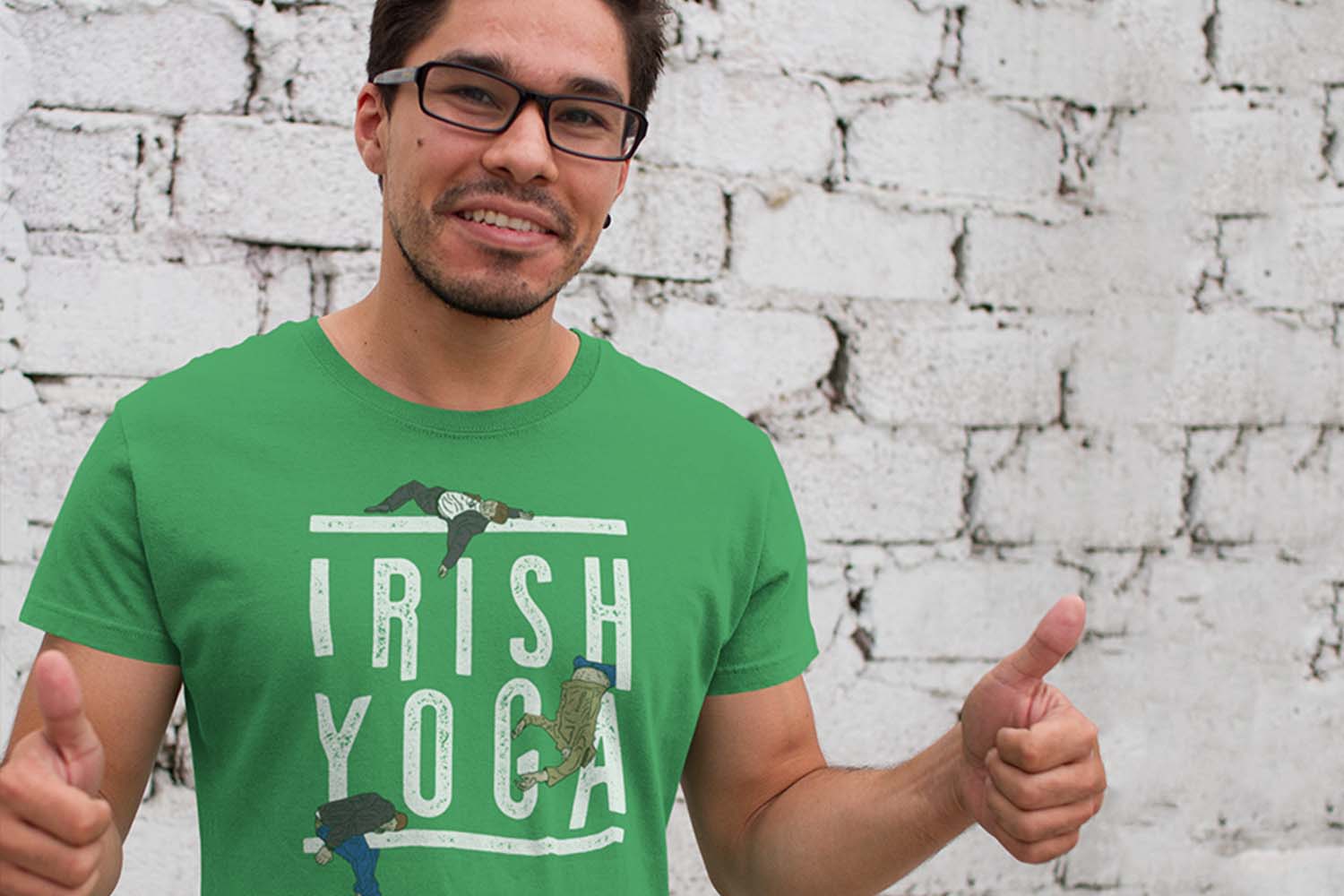
The holidays are better when there’s a lot of alcohol on hand. Whether that booze is used for celebration or to distract yourself from the presence of that one cousin (you know the one), alcohol is rightfully a big part of the most festive days of the year.
More than any other event, St. Patrick’s Day stands alone when it comes to holiday drinking. While St. Patty’s may seem like a fairly low-key holiday to some, it’s always an excellent time to test the limits of your alcohol intake. Instead of doing that alone in your bedroom, why not make a game out of it?
Aside from from having the best St. Patrick's Day shirts you can find, here’s how to take your Saint Patrick’s Day to the next level and make it one that you will never forget. Actually, if you’re bad enough at these games, you probably will forget it—but that’s neither here nor there.
What Does Saint Patrick’s Day Mean?

What is Saint Patrick’s Day? Most people just associate the holiday with shamrocks, beer, and a metric f***-ton of the color green, but what is it, really?
A Brief History of St. Patrick’s Day
St. Patrick’s Day is a long-running tradition initially started to celebrate Irish culture. It’s been a religious holiday in Ireland for over a thousand years, with its origins in a holy man who lived in the fifth century whose name was – you guessed it – Patrick.
According to our most accurate historical records, St. Patrick was born in Roman Britain. However, when he was a teenager, Patty was kidnapped and brought to Ireland to be a slave. If you thought you had it rough in high school, St. Patrick had it rougher.
Around six years later, he escaped captivity. Fast forward a few years later, and a fully grown Patrick returned to Ireland and brought Christianity back with him. Patrick’s return kick-started the prominence of Christianity in Ireland, and it helped to introduce some very important concepts to Christian theology – like God essentially being a shamrock.
Saint Patrick passed on into the next life on March 17th, which is why we celebrate his memory on that date. However, it still took a long time for people to turn that date into the holiday that we know and love today.
Around the ninth century, people in Ireland started to observe St. Patrick’s Day almost 400 years after Patrick's death to celebrate their Irish culture, heritage, and traditions. It was a day for attending church, then celebrating with copious amounts of food, drink, and dancing. That sounds pretty Irish to us.
The Americans Did It First
Funnily enough, the first recorded Saint Patrick’s Day parade actually took place in America—not Ireland—on March 17th, 1601, in a colony in Florida. Since then, St. Patrick’s Day parades have become incredibly popular, with hundreds of processions happening every year in cities and towns all over the United States.
While they used to be focused on celebrating people who have Irish heritage, these parades and the holiday as a whole are now loved by people of all cultural backgrounds. Irish or not, you’ve got to love St. Patrick’s Day!
So… Alcohol?
When St. Patrick’s Day comes around, one of the best ways to celebrate is by drinking as much green beer as you can stomach and reveling in the glory of the occasion.
Of course, the actual Patrick would likely be appalled at how we celebrate him, but don’t let that stop you! Just because Patty was a saint doesn’t mean you have to be.
Lent or St. Patrick’s Day?
One of the funniest things about Saint Patrick’s Day is that it falls in the middle of Lent, a Catholic holiday focused on abstaining from something, often alcohol.
However, since Saint Patrick’s Day is technically a Christian holiday, Catholics can put a brief hold on Lent and have a day to kick back and let loose. Even the most devoted Catholics take this holiday as a good reason to drink a couple (or more than a couple) beers and have a good time.
Green Beer? Yes, Please!

Since Saint Patrick’s Day is meant to be completely awash in green, why not make the beer green too?
Ever since it was invented in the early 20th century, green beer has become one of the most iconic and essential parts of a Saint Patrick’s Day celebration done right. If you’re drinking beer to celebrate, it’s almost a sin to drink anything that doesn’t isn’t colored in a vibrant shade of green.
Of course, we won’t judge you, but come on – when else are you going to have a good excuse to drink something green that doesn’t have kale as the primary ingredient?
What Are the Best Saint Patrick’s Day Drinking Games?
If you’re looking for even more excuses to throw back some green beers while you’re getting absolutely lit on Saint Patrick’s Day, you’ll love these drinking games!
Irish Poker
If you have a horrible poker face, don’t worry – this is nothing like actual poker.
Here’s how you play:
- Get out a deck of cards and remove the joker.
- Put the cards face down in the middle of your group. You can play this game with as many or as few people as you’d like.
- The first player has to guess whether the card on top is black or red.
- If they are right, they don’t have to drink that round. If they are wrong, they have to drink a number of sips corresponding to the number on the card.
- Put the card into a discard pile.
- The person who is to the first player's right then repeats the process.
- Keep going until you’re out of cards—or out of your minds. Whichever happens last.
Green Potato
You don’t actually need a green potato to play this game. Honestly, it doesn’t even have to be a potato. Just grab something and pass it around. Green potato is just classic hot potato… but with more beer.
- Gather your party in a circle with a potato.
- Next, one player closes their eyes and turns on the music while everyone else passes the potato around in the circle.
- Keep passing the potato until whoever is in charge of the music suddenly turns it off. Whoever is holding the potato at that time has to take a shot of green beer.
- Whoever just lost is now in charge of the music.
-
Rinse and repeat until plastered.
Lucky Charms
No, we’re not talking about the cereal. Sorry to disappoint.
For this game, you’ll need dice for every person playing. Lucky Charms works best in groups of five to seven people.
- Select one player to be “lucky” for that round.
- The person who is “lucky” rolls their dice. Make sure everyone knows what number is rolled.
- After the “lucky number” is rolled, everyone else rolls their dice.
- Whoever rolls the “lucky number” has to take a drink. However, if nobody rolls the “lucky number,” then the “lucky” player has to take a drink.
- Repeat with a new “lucky” player every round. Keep going until you literally can’t anymore.
Irish Rock, Paper, Scissors
This is the perfect game for large groups of people. Anyone can be the winner, as long as they’re lucky. However, the winner doesn’t have to drink—so are they really winning?
- Everyone in the room has to find a rock, paper, scissors partner. Whoever loses two out of three rounds is out of the game, and whoever wins gets to move onto the next level.
- Everyone who loses the game has to take a shot once every minute until the game ends.
- When someone wins, they have to face another winner and keep going until they either lose or get down to the final two.
- In this final round, the last two standing have to face off in front of everyone. Whoever loses the final round has to chug an entire drink in front of everyone. When they are done, the game is over.
Get Lucky
These are, of course, just a few of the many drinking games that pair perfectly with Saint Patrick’s Day festivities. With enough creativity, you can keep coming up with your own booze-fueled party games, no matter how ridiculous they might be.
Whatever game you’re playing, make sure you put your best foot forward by wearing something that matches up with your competitive Irish spirit.
This shirt will let people know that you’re the true champion no matter what happens. If you win, you get honor and dignity, but you get an extra dose of green beer if you lose. You’re winning no matter which way you look at it!
If you’re looking for a more fashionable way to take on St. Patty’s Day, check out the selection of iconic and fashionable apparel in our shop. For every occasion, we’re here to help you stand out. Stay sharp out there!
Sources:
Saint Patrick's Day | History, Traditions, & Facts | Britannica
Green Beer Recipe | Allrecipes
St. Patrick's Day 2021: History, Folklore, Recipes, and More | The Old Farmer's Almanac


















